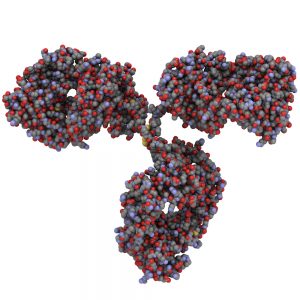Borrelia
Lyme borreliosis (or Lyme disease) is a bacterial, tick-transmitted disease of animals (dogs, horses, probably cats) and humans. Other mammalian and avian species can become infected but do not develop overt clinical signs. In humans, the most common clinical manifestation of infection is a large red rash (erythema migrans), which varies in its size and appearance, and generally resolves without treatment.
The Native Antigen Company provides monoclonal antibodies, antigens and immunoassays specific to Borrelia garinii, B. afzelii, or B. burgdorferi sensu stricto which are ideal for use in a wide range of research studies.
Borrelia Background
Five Borrelia species have been reported to infect humans, including B. burgdorferi sensu stricto in North America and Europe, B. garinii, B. bavariensis, B. afzelii in Europe and Asia, and B. spielmanii in Europe. B. afzelii and B. garinii account for most cases of Lymes disease in Europe (Wang, G.), which are transmitted by the hard tick Ixodes Ricinus and maintained in small vertebrates and birds. They all belong to the Borrelia burgdorferi sensu lato species complex of spirochetes of the genus Borrelia, family Spirochaetaceae. In nature, spirochetes are maintained in a transmission cycle between hard ticks of the Ixodes species and a reservoir of small-medium sized vertebrate, and in some cases birds. In humans, infection occurs through the bite of a tick infected with the spirochete. Infection with Borrelia in humans can cause a condition known as Lyme disease or Lyme borreliosis.
In humans, the most common clinical manifestation of infection is a large red rash, referred to as erythema migrans, which can vary in size and appearance. Additional symptoms include fever, chills, headache, fatigue, joint pains and swollen lymph nodes. However, in some severe cases, the infection may spread to joints, the nervous system or heart and clinical symptoms including neck stiffness, arthritis, facial palsy, heart palpitations, nerve pain, numbness and memory loss may develop (CDC). Erythema migrans generally resolves without treatment. However, patients with Lyme disease are often treated with antibiotics to prevent dissemination and potential development of more severe clinical symptoms. Currently, no licensed vaccine to prevent Borrelia infection is available.
References
- Wang G, Liveris D, Mukherjee P, Jungnick S, Margos G, Schwartz I. 2014. Molecular Typing of Borrelia burgdorferi. Curr Protoc Microbiol. Aug 1;34:12C.5.1-31
- Centers for Disease Control and Prevention: Lyme Disease
3. Lyme Disease: Prevention, Identification, and Treatment Options
Borrelia Antigens
We offer an extensive range of Borrelia antigens, expressed as recombinant proteins in E. coli.
These antigens are suitable for use in assay development, vaccine research and as antigens for the preparation of Borrelia-specific antibodies.
Borrelia Antibodies
We offer monoclonal and polyclonal antibodies specific to Borrelia, suitable for use in ELISA, Western blotting and immunofluorescence applications.
Questions?
Check out our FAQ section for answers to the most frequently asked questions about our website and company.





